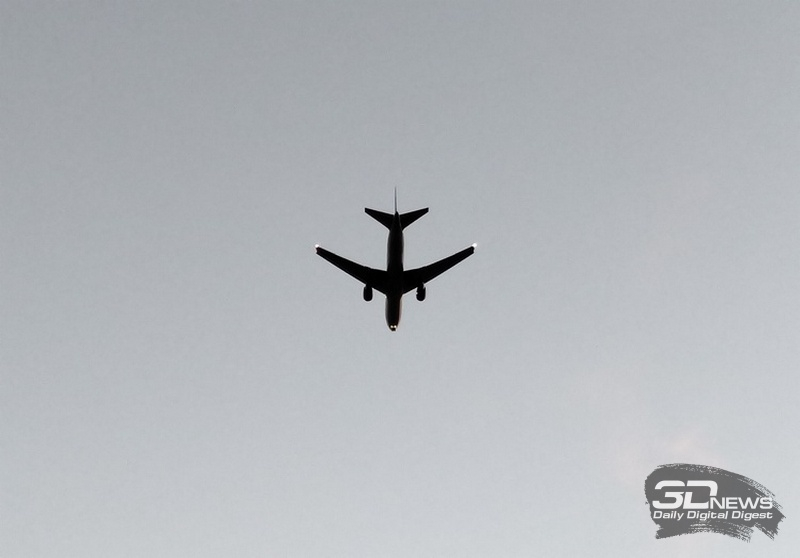Commercial aviation promises to be the most difficult area for decarbonization. There is no energy source for aircraft today or in the foreseeable future that is as capacious as fossil fuels. Wireless power sources could be an alternative to loading planes with tons of batteries or tanks of dangerous hydrogen. They could, but they are unlikely to become so — planes need a lot of energy, and its transmission from the ground to the aircraft is an extremely non-trivial task.

Image source: McKibillo/spectrum.ieee.org
The IEEE Spectrum online journal of the Institute of Electrical and Electronics Engineers (IEEE), a non-profit engineering association in the United States, published what could be called a policy article on wireless microwave power for commercial airliners. The author of the article immediately acknowledges that “nothing developed to date can store energy as cheaply and densely as fossil fuels, or fully meet the needs of commercial air travel as we know it.” Physics does not prohibit the use of radiation in aviation to transmit power. The obstacles may be technological or legal. But other alternatives to reducing the carbon footprint of aircraft seem even more disastrous.
Microwave energy can be transmitted from the ground to an aircraft using a phased antenna array. Such an antenna can electronically control the beam direction and focus it with high precision without the need for mechanical rotary systems. Since the aircraft must be confidently located within the visibility range of such an antenna, and the Earth is spherical, the transmitting antennas (arrays) must be located at a distance of approximately 200 km from each other. By the way, on the sea-ocean too, if we want to send aircraft with microwave power to another continent. In the case of flights over mountains, the antennas will have to be located even more densely, taking into account possible interference. In this case, each antenna will guide the aircraft at a distance of up to 100 km, after which it will be picked up by another on course.
The creation of an array of transmitting antennas will be the construction project of the century. An average airliner with a fuselage and wing area of about 1000 m2 will be able to carry a receiving antenna about 30 m wide on the lower part of the wings and body. Taking into account the most optimal radiation for propagation in the atmosphere with a wavelength of 5 cm (it is not so short to be absorbed by clouds and not too long-wave to require too large a receiving element equal to half the wavelength), the dimensions of the transmitting phased antenna array should reach 170 m. And so every 200 km. Only government programs can handle this, but not private ones. Are there many countries ready to accomplish such a feat? China is not an option.
Regarding the level of required power supply, it is worth saying the following. During takeoff, a Boeing 737 consumes approximately 30 MW of power. If we can provide power of such power, it will reach the rectifying antenna (rectenna), which must be manufactured taking into account aerodynamics and built into the lower part of the aircraft. Moreover, the maximum transmission will only occur when the aircraft flies over the transmitting station, and in other cases, the energy will “hit” the front and rear projection of the aircraft, mainly the edges of the antenna, increasing the power transmission density to the limit on these parts of the antenna.

Using the Boeing 737 and its requirements as an example, about 25 watts would be incident on each square centimeter of the rectenna. Given the 2.5 cm (half wavelength) spacing of the solid-state receiving elements of the rectenna, about 150 watts would be incident on each element, which is dangerously close to the ultimate power density of any solid-state power conversion device. In other words, there are no solid-state materials that are guaranteed to safely receive microwave energy with a margin of safety. Finally, the efficiency of such power transmission methods is barely approaching 30%, which casts doubt on the benefits of switching to such an alternative to fossil fuels.
Further, according to estimates, the electric field around the plane will have a strength of about 7000 V/m – only three times weaker than in a microwave oven. The body of the plane will reliably protect passengers, and especially curious ones – they will be protected by metal mesh on the windows, like on the doors of a microwave oven. Birds will not have such protection, but since the focusing beam will move quickly behind the plane, the birds simply will not have time to prepare in the air. This, as the developers of transmitting microwave systems admit, will take at least 10 minutes. The environment will not suffer much, but the company’s lawyers will have to prove this to passengers and legislators.
Doubts about the feasibility of using microwave radiation to transmit energy over long distances without wires do not hinder research in this area. NASA and private companies, as well as academic institutions, are conducting experiments with transmitting microwave energy from space. This is facilitated by progress in the field of semiconductor technology and solid-state receiving and transmitting elements. If earlier these were bulky analog devices like klystrons, today they are being replaced by compact semiconductor transmitting platforms.
In 2022, for example, Auckland startup Emrod demonstrated how promising the semiconductor approach could be. The company conducted a demonstration for Airbus in Germany, beaming 550 watts over a distance of 36 meters. The beam transmitted 95% of the emitted energy, which is much better than using klystrons or magnetrons. Certainly, there is a future in this area, if there is or will be one.
There is also the issue of interference with radio signals. Even if a microwave power transmitter could successfully convert 99% of the waves into a narrow beam, the 1% leakage would still be a hundred million times more powerful than the permitted radio power in the 5-cm range (the range used for space and amateur radio). Surely these are not all the problems with microwave power transmission, but even these are enough to doubt the feasibility of the projects.
Unfortunately, other alternatives also have their own inherent drawbacks. The most promising of the alternative types of fuel supply for aircraft – synthetic or plant-based fuel – is either too expensive or turns out to be more harmful to produce than fossil fuels. Swapping one thing for another by increasing the price tag is not even pointless. It is stupid. Against this background, microwave energy transmission to an aircraft no longer seems like a crazy undertaking. After all, at the dawn of aviation, aircraft were also considered the domain of madmen, but it took off! In every sense.